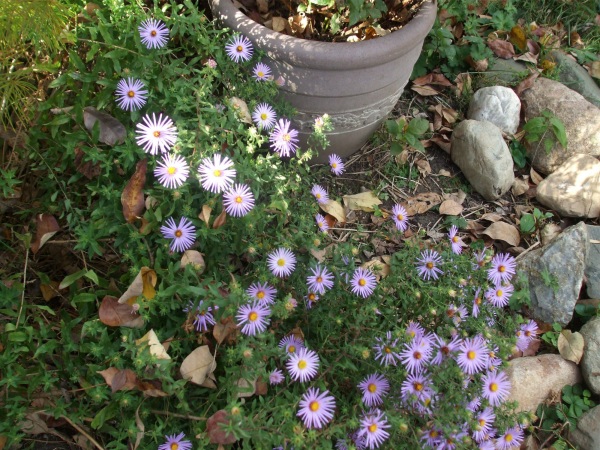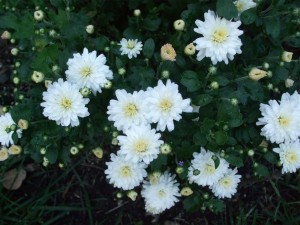
'Raydon's Favorite' aster. (C) Jo Ellen Meyers Sharp
The Midwesterners’ choices for late blooming perennials have taken a giant step past everyday chrysanthemums in the last several years.
Ready for the late season spotlight are some, newer yet under used, perennials that delight gardeners in Minneapolis, Chicago, St. Louis, Indianapolis, Cincinnati and beyond. These are the plants that need the heat of summer to build up their resources to color the landscape well into fall
Here’s a sampler:
‘Raydon’s Favorite’ aster kicks into gear in September and keeps going until October in the upper Midwest or November in the lower Midwest. Hardy in USDA Zones 3 through 8, ‘Raydon’s Favorite’ is a cultivar of the North American native aromatic aster with a newer tongue twister, scientific name Symphyotrichum oblongifolium. It formerly was Aster oblongifolium and may be listed that way on plant tags, in catalogs and other references.
This deer resistant plant can be grown in full- to part sun in average soil. It gets about 2 feet tall with a slightly relaxed habit, has an 12- to 18-inch spread and is drought tolerant. The flowers can be cut for indoor enjoyment. This cultivar is not affected by powdery mildew, a common pest on this species. Introduced in 2000, ‘Raydon’s Favorite’ is readily available at garden centers or through mail order and online retailers. A good alternative is ‘October Skies.’
Consider pairing asters with plants that also have good fall color, such as ornamental grasses, stonecrop (Sedum), Amsonia or shrubs with late blooming flowers like peegee hydrangeas (Hydrangea paniculata) or spectacular foliage like ninebark (Physocarpus) and oakleaf hydrangea (H. quercifolia).
Bugbane, cohosh or snake root is a multi-named native species that also has undergone a scientific name change. Formerly Cimicifuga, it now is Actaea. Regardless, this perennial looks good in its native species form or as one of the purple-leafed cultivars.

Hillside Black Beauty bugbane. Photo courtesy of perennialresource.com
‘Black Negligee’, ‘Hillside Black Beauty’ and ‘Brunette’ all get in the 4- to 7-foot tall range with a spread of about half that. They do well in shadier, moist areas of the garden. The long, fragrant white or pinkish-white flowers begin to bloom in August and continue for about six weeks. Place in the back or the middle of the flower bed where shorter plants can enhance the base of the tall bugbanes. It is hardy in USDA Zones 4 through 8. Bugbane is deer resistant and is readily available through mail order and online catalogs. Some garden centers also may carry the plant.
‘Frosty Igloo’ isn’t your average mum. This mum bloomed in Indianapolis from July through November in its first year in trials. Granted, it was a cooler than normal summer; however, the white flowers stayed crisp and clean and the foliage fresh and green the whole time.

Frosty Igloo mum. © Jo Ellen Meyers Sharp
Marketed as a hardy mum, the Igloo series was introduced as a Dendranthema, but recently changed its scientific name to Chrysanthemum. Reliably hard to -20 degrees F, the plants get about 12 inches tall and slightly wider. Plant in full sun for the best flowering.
Most gardeners have grown a lot of mums and know that they don’t always come back. This one is very different and quite a performer with a nice rounded shape that is covered with flowers that come in five colors. Introduced by Blooms of Bressingham, it can be difficult to find. It comes in other colors, too, including pink and orange tones.
